Saint Mary of Egypt was a prostitute in the 5th century in Alexandria, who was converted at the Church of the Resurrection in Jerusalem. She retreated into the Palestinian desert, in the Jordan region, where she lived for the rest of her days in solitude and penitence.
This icon is a faithful representation according to the description of her, written in the 7th century during her life and attributed to Sophronios. Like a “shadow”, her face appears emaciated by fasting and by the harshness of her life, while her body is skeletal. Her white, wool-like hair is sparse, and she is wearing a simple cloak draped over her skin which has been bronzed by the sun. The white highlights are related to uncreated light, a sign of sainthood.
The scene commemorates the meeting with the monk Zosime, who came to visit her at the end of her life. Wearing a priestly stole, he gives her communion, consisting of bread soaked in wine, with the aid of a long-handled liturgical spoon used in the Byzantine church. The saint is opening her mouth to receive the communion which she takes with her right hand. Her left hand folded over her breast hides her nudity in a gesture of modesty.
Monasticism developed from the 4th century onwards in Egypt and Palestine, following the great hermit Saint Anthony, who began the movement and whose life is known to us by the account written by Athanasius of Alexandria shortly after the saint’s death, in 356. Mary of Egypt is one of the rare known female hermits.
R. Z.

City of Paris municipal collection's website
The collections portal can be used to search the collections of Paris’s 14 municipal museums (approximately 336,000 works, including 43,000 belonging to the Petit Palais).
It is also possible to download around 12,000 images of the museum’s works free of charge.
Access the Museums of the City of Paris collections portal
Extern databases
Discover a selection of databases online presenting works from the Petit Palais or documents concerning the history of the museum.

